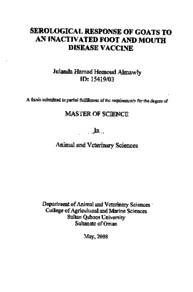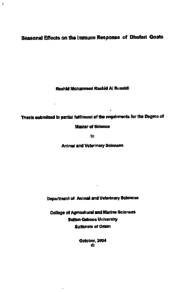Document
Serological response of goats to an inactivated food and mouth disease vaccine
Publisher
Sultan Qaboos University
Gregorian
2008
Language
English
English abstract
Goats are the main source of meat in Oman as their meat is the most preferred by the local population. Infectious diseases such as Foot and Mouth disease (FMD) constitute a major impediment to animal production and are considered to be an important limiting factor in the maintenance of livestock such as goats. FMD is considered to be endemic in all regions of Oman. In order to control and prevent disease outbreaks a trivalent killed vaccine containing types O, A and Asial FMD virus is used for vaccination in the Sultanate. To ascertain the effectiveness of FMD vaccine the present study highlights the serological response of 4 breeds of goats to FMD vaccine containing FMD virus types O, A and Asial. Twenty goats from four breeds, (Jabal Akhdar, Sharqia, Shami and Crossbreed between Shami and Sharqia) four months of age of both sexes which had not been previously vaccinated against FMD were selected and maintained together. All animals were screened for antibodies against types Asia 1, A and O monisia. Thereafter, each animal was vaccinated with 1 ml of the inactivated FMD vaccine, A dose of 1 ml contained 5.08 PDso, 4.28 PDso, 4.95 PDso of O, A and Asial FMDV antigens respectively. Blood samples were collected from each goat on days 7, 14, 21, 28, 60, 90, 120, 150, 180, 210, 240 and 270 post vaccination. A liquid phase blocking ELISA was performed. The assay is based on the specific blocking of a defined amount of FMDV antigen by antibodies in the test sample during the liquid phase. The results of the study demonstrated that the FMD vaccine, presently used in Oman for goats does not give adequate protection for 6 months as indicated by the manufacturer. Also the antibody response against FMDV type A was the least protective of the three serotypes. An acceptable level of protection for all three types was only for 4 months. The genetic background of the animals appears to have an effect on the serological response. A significantly better response was observed in Jabal Akhdar goats in comparison to the other 3 groups against type O, A and Asial. The reasons for these apparent breed differences need further investigation. Furthermore, alternative FMD vaccine and vaccination strategy need to be explored for Omani goats
Description
Thesis
Member of
Resource URL
Arabic abstract
يمثل الماعز المصدر الرئيسي لإنتاج اللحوم في عمان، حيث أن لحوم الماعز هي المفضلة لدى الكثير من المواطنين. تشكل الأمراض المعدية مثل مرض الحمى القلاعية عائقا كبيرا بالنسبة للإنتاج الحيواني وتعتبر عاملا مهما في إعاقة تنمية الثروة الحيوانية، يعتبر مرض الحمى القلاعية مرض مستوطن في جميع مناطق السلطنة. لذلك وبغرض السيطرة على المرض ولمنع حدوث وبائيات لهذا المرض تم إستخدام لقاح ثلاثي ميت يحتوي على فيروس مرض الحمى القلاعية للعترات A O و Asial لتحصين الحيوانات في السلطنة. تسلط الدراسة الحالية الضوء على الإستجابة المناعية لأربع سلالات من الماعز للقاح مرض الحمى القلاعية المحتوي على العترات الثلاث (0، A و Asia1 ). تم إختيار عدد 20 من الماعز من اربع سلالات (سلالة الجبل الأخضر ، الشرقية , الشامي و هجين بين الشامي و الشرقية) ذات عمر أربعة أشهر من كلا الجنسين والتي لم يسبق تحصينها بهذا اللقاح من قبل. تم فحص جميع الحيوانات وذلك للتأكد من خلوها من الأجسام المناعية الفيروس مرض الحمى القلاعية للعترات A O و Asia1 . وبعد التأكد من ذلك تم تحصين كل حيوان بمليلتر واحد من اللقاح الثلاثي الميت المحتوي على فيروس مرض الحمى القلاعية العترات A ، O و Asia1 . كل جرعة (مل واحد من اللقاح يحتوي على جرعة حماية تعادل5 . 08 و 4 . 28 و 4 . 95 العترات 0 ، A و Asia1 على التوالي من فيروس مرض الحمى القلاعية. تم جمع عينات الدم في اليوم 7، ،14 21 , 28, 60, 90, 150 , 120 , 210 , 180 , 240و 270 بعد التحصين. تم إستخدام إختبار Liquid phase blocking ELISA والذي يعتمد أساسا على المنع المحدد لكمية معينة من الأنتيجينات بواسطة الأجسام المضادة في العينة المراد فحصها وذلك في المرحلة السائلة للإختبار. أظهرت نتائج الدراسة أن لقاح الحمى القلاعية المستخدم حاليا في عمان للماعز لا يعطي حماية تكفي لمدة 6 أشهر كما ذكرت الشركة المصنعة للقاح. كانت الاستجابة المناعية ضد فيروس الحمى القلاعية العترة A كانت الأقل في الثلاث عترات المستخدمة في اللقاح المستوى المقبول من الحماية الثلاث عترات كان فقط لمدة 4 شهور، يمكن أن يكون الخلفية الوراثية تأثير في مدى الاستجابة المناعية للتحصين ، يظهر هذا التأثير جليا في تفوق سلالة ماعز الجبل الأخضر في الاستجابة المناعية مقارنة بالسلالات الثلاث الأخرى ضد العترات الثلاث. يحتاج المزيد من الدراسة للوقوف على أسباب الإختلافات الظاهرة بين السلالات المختلفة للماعز. من ناحية أخرى نوصي بوضع استراتيجية جديدة للتحصين ضد الحمى القلاعية في السلطنة، اضافة إلى البحث عن لقاح بديل عن المستخدم حاليا۔
Category
Theses and Dissertations


